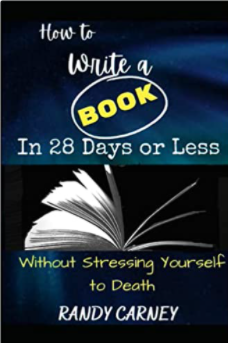Writing a first-time book, the big picture in a nutshell.
Today I’m talking about writing a first-time book. I want to talk about the big picture in a nutshell.
Overview
I’ll talk about the two different kinds of books that you can write and then give you steps for making a basic book in the first category. Then I will talk about how you can make that look fabulous.
Then in the second category, I will talk about four methods of writing that book.
Okay, writing a first-time book in a nutshell. You might not have thought that you could do this but you can.
Step One
Now I’m going to talk first about writing nonfiction.
As you think about writing nonfiction, first of all, you should write a basic book. After that, you should expand that book, edit it, and make it fabulous.
That’s the first two of the four steps to success that I have outlined in book writing and marketing.

Ten Chapters
In our nonfiction book, my advice to you is to write a basic book. To do this, write the 10 most important chapters of that basic book; your 10 key chapters. You can do it like this:
Chapter One
The first chapter will be telling why this book is important. Why people should buy your book, why people should read your book, how it will help them. Take them to everyone’s favorite radio station: which is WIIFM – What’s in it for me? Talk to them about that.
Chapter Two
Chapter two would be an overview of the plan that you have to solve their problem. Most nonfiction books are going to be ways that you would go about helping people solve a particular problem.
Chapters Three Through Nine
Then in chapters three through nine, you take seven steps to solve that problem. Now, they may not be chronological, sometimes they are chunked, they are equal, just put down in chunks, side by side, you can do that too. However, if there is a series of steps that go one before the other, then you would want to do that.
I would recommend that you come up with seven. You might have more ideas, but I suggest that you come up with seven steps to the solution.
Chapter Ten
Then in chapter 10 you would have the summary of that and the next steps they could take.

Make it Fabulous!
The second thing I’m going to talk about with writing nonfiction books is take your basic book, and make it fabulous.
What you will do is take your basic book, which is uniquely you because you have come up with those ten chapters, and you’ve come up with your experiences out of your own mind. This is where you add them in.
Also compare books on that same topic. Look at their tables of contents, see if there’s anything that you have not covered on that topic in your book. Then you will add those chapters in yourself.
So you will take that basic book and edit it somewhat by cutting out some of the unnecessary words and doing a light edit.
Then you will expand it by adding more material that needs to be added. Add in more stories and come up with some of your own stories. Sometimes you can tell your own story but to protect yourself or to keep people from thinking that all you ever do is talk about yourself, you can change the name of the character that you’re talking about.
So you write a basic book, then you expand it and edit it and make it a fabulous book.
Writing Fiction

The second category would be writing a fiction book. This depends on your personality. What kind of person are you?
Are you an outliner? If you are then you need to outline your entire book. Go for it if you’re really good at that. Then go through and produce a detailed outline for your book.
Others, that just drives them crazy. Some people are known as being “pantsers” which means they write from the seat of their pants.
If that’s you, then you have to have the basic idea of your book. You need to know three conflicts that would occur about a third of the way through, halfway through, and three fourths of the way through. Then you would just write from the seat of your pants, writing toward those conflicts or disasters.
Finally in the hand you bring the resolution.
There is a third method if you would like something between those two. It is from a writer named Randy Ingermanson He has written a book called “The Snowflake Method” which talks about coming up with a basic ideas of where you’re going to go.

He talks about fleshing out your characters and giving good summaries of your characters. Then he takes your book in one sentence, then take that one sentence and come up with a one page statement of your book.
Then you take each of those sentences and you write paragraphs on each of those sentences and come up with a synopsis of your book.
Combining that with what you have done for your characters, you can come up with a good nonfiction book.
(I don’t get any commission off of his book but I do recommend it. I think it is very good.)
There’s a fourth one and it is my combination. If you have read my book “How to Write a Book in 28 Days or Less Without Stressing Yousrelf to Death,” you will notice that I take an outline and turn it into a special type of writing plan.
Some call it a blueprint like a blueprint for a house. You can do that for both fiction and nonfiction.

Having said that, I would urge you to go to Amazon and purchase my book “How to Write a Book in 28 Days or Less Without Stressing Yourself to Death.”
I hope this has been helpful to you and also if you’d like more tips like these click on www.randycarney.com. There, you will find many more videos, blog posts and tips like these.
Well, it’s good to talk with you again. I hope you have a wonderful day. Remember, YOU CAN WRITE A BOOK!

